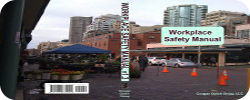Previously, OSHA included “flexible language” in 1926.501(b)(13) because of concerns expressed during the rulemaking period about the feasibility and safety of using conventional fall protection for residential construction. The wording of this section is: “Residential construction.” Each employee engaged in residential construction activities 6 feet (1.8 m) or more above lower levels shall be protected by guardrail systems, safety net system, or personal fall arrest system unless another provision in paragraph (b) of this section provides for an alternative fall protection measure. Exception: When the employer can demonstrate that it is infeasible or creates a greater hazard to use these systems, the employer shall develop and implement a fall protection plan which meets the requirements of paragraph (k) of 1926.502. Note: There is a presumption that it is feasible and will not create a greater hazard to implement at least one of the above-listed fall protection systems. Accordingly, the employer has the burden of establishing that it is appropriate to implement a fall protection plan which complies with 1926.502(k) for a particular workplace situation, in lieu of implementing any of those systems.”
After OSHA established the regulation, it became expressed by major groups the residential construction industry needed more flexibility to comply with the regulation. Hence, OSHA issued Instruction STD 3.1 on December 8, 1995. This was to be considered an interim compliance policy and it allowed residential construction employers to use specific alternative procedures instead of conventional fall protection. It was not necessary to demonstrate a prior showing of infeasibility or greater hazard and without a written, site-specific fall protection plan. This was never intended to be a permanent policy.
On June 18, 1999, OSHA issued STD 3-0.1A (STD 03-00-001), which was a plain language replacement for STD 3.1. In this document OSHA clarified, for interim purposes, that residential construction was characterized by wooden materials, as opposed to steel and concrete and incorporated traditional wood framing techniques.
Upon issuing STD 03-00-001, OSHA file an Advanced Notice of Proposed Rulemaking (ANPR), with the following explanation: “OSHA emphasizes that the extensive rulemaking process completed in 1994 established that the fall protection requirements in the rule are reasonably necessary and appropriate to protect employees from the significant risks of fall hazards. Providing such protection was demonstrated to be both technologically and economically feasible. . . . However, because of . . . concerns raised by employers engaged in . . . [certain residential construction] operations . . . we are seeking additional information.”
OSHA received several comments in response to the ANPR from unions, members of the residential construction industry and other interested parties. Some supported the withdrawal of STD 03-00-001, while others opposed the plan to withdraw.
- The United Steelworkers of America “strongly urge[d]” OSHA to withdraw the directive and commented that it did “not believe that the alternative procedures [in the directive] provide any positive protection for residential construction workers.”
- Web-Tech Safety Products commented that “the scale of exemption from fall protection provided under STD 3.1/3-0.1A is no longer necessary.”
- Others, however, expressed ongoing concerns about the feasibility of conventional fall protection for certain types of residential construction work and urged OSHA to retain the interim guidance.
- The Residential Construction Employers Council (RCEC) argued in favor of the “[c]ontinued use of the Interim Fall Protection Standard,”
- The National Roofing Contractors Association (NRCA) “strongly encourage[d] OSHA to keep Directive STD 3-0.1A in effect.” They further argued, in agreement with the NAHB, that the use of personal fall arrest systems for roofing work exposed workers to fall hazards for a longer period of time and created other hazards, such as tripping and burning.
- The National Association of Home Builders (NAHB) (Ex. 3-2453)1 was concerned about a lack of proper attachment points for personal fall arrest equipment during some types of work, asserting that before the completion of a roof system “there is no attachment point for an anchor that meets . . . [OSHA] requirements.” (As noted below, however, the NAHB has subsequently changed its position on STD-03-00-001.) The RCEC (OSHA-S206C-2006-0924-0172) suggested that personal fall arrest cannot be used for the installation of roof sheathing because “multiple anchor points would be required for repositioning and it would create a swing fall hazard due to the amount of rope needed to adequately traverse the roof[.]”
After the comment period ended, OSHA decided to withdraw the interim requirements and posted this statement upon issuing STD 03-11-002.
“OSHA believes that personal fall arrest systems generally can be used safely and effectively in residential construction, including for roofing work. The use of adjustable and retractable lanyards can greatly minimize the tripping or entanglement hazards that the NRCA was concerned about. Such hazards can also be controlled using safe work practices, such as coordinating the movements of workers on the roof. And the Agency is not persuaded by the RCEC’s suggestion that the use of personal fall arrest systems during the installation of roof sheathing exposes workers to swing hazards. If a fall occurs in an established work zone, a properly engineered fall arrest system and safe work practices will prevent the worker from being subjected to a swing hazard. Horizontal lifelines that allow the anchorage point to move along with the worker can also address swing hazards. Finally, based on enforcement experience, OSHA is convinced that fall arrest systems can be used with commercially-available anchors that can be installed without increasing the duration of exposures to fall hazards or impeding production schedules. . .
“OSHA notes that employers in residential construction will often be able to use personal fall restraint systems in situations in which it might be problematic to use personal fall arrest systems. Fall restraint systems can be used effectively to prevent falls by tethering workers to structural members, such as braced trusses and studs. In addition, on sheathed floor and roof trusses, personal fall restraint systems can prevent workers from reaching an unprotected side or edge. Because fall restraint systems are designed to prevent a worker from falling (as opposed to arresting a fall once it occurs) . . .
“In any event, even if there are some isolated residential construction tasks for which it is infeasible or creates greater hazards to use personal fall arrest systems, that does not end the Agency’s inquiry into whether “for most residential construction employers complying with . . . [1926.501(b)(13)] is infeasible or presents significant safety hazards.” Personal fall arrest is just one type of conventional fall protection that can be used to comply with 29 CFR 1926.501(b)(13). Employers can also use guardrail systems or safety net systems. And, as mentioned previously, employers can have their personnel work from ladders, scaffolds, or aerial lifts in lieu of complying with 1926.501(b)(13). . .
“Overall, the comments to the ANPR did not persuade OSHA that “most residential construction employers” would be unable to find a safe and feasible means of protecting workers from falls in accord with 29 CFR 1926.501(b)(13). When OSHA promulgated Subpart M in 1994, it concluded that it was generally feasible for employers to provide conventional fall protection for residential construction work, and OSHA has concluded that the ANPR record, considered as a whole, does not demand a different finding.”
This ruling is effective 16 Dec 2010 and will be enforced beginning 16 Jun 2011. The confusion is removed, the rule is simple. Construction activities six feet or more above lower levels shall be protected by:
- guardrail systems,
- safety net systems, or
- personal fall arrest systems.
Exception: When the employer can demonstrate that it is infeasible or creates a greater hazard to use these systems, the employer shall develop and implement a fall protection plan. At this point, additional rules apply.

